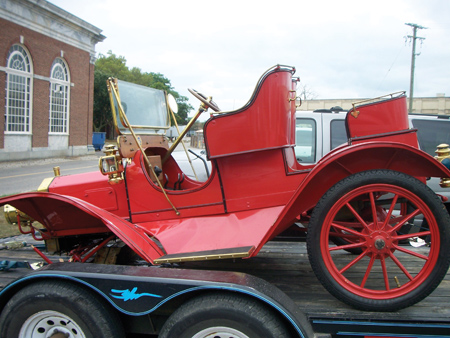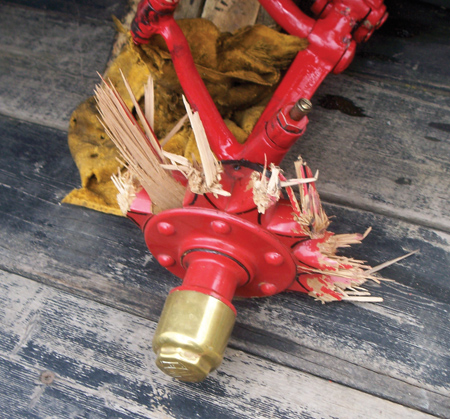
 Dad got in a car accident. When my husband told me, we were parked outside a Holiday Inn near Lansing, Mich., after spending a drizzly September day driving 100 miles from Dearborn in my family’s 1909 Brush – a true “horseless carriage” made in Detroit for less than a decade that has a one-cylinder, 10-hp engine, wooden frame, wooden axles and wooden wheels.
Dad got in a car accident. When my husband told me, we were parked outside a Holiday Inn near Lansing, Mich., after spending a drizzly September day driving 100 miles from Dearborn in my family’s 1909 Brush – a true “horseless carriage” made in Detroit for less than a decade that has a one-cylinder, 10-hp engine, wooden frame, wooden axles and wooden wheels.
I pulled the cushion off the Brush’s backseat and dug for my cell phone among our rain gear and tools. I called Dad, hands shaking.
“What happened?” I asked.
“Well, the car’s ruined,” he said.
What a relief. This was the first sign that Dad was just fine, or would be after a few beers. The car, on the other hand, was definitely not.
Dad had been driving our 1908 Model S Ford. A bright-red roadster and backward big brother of the Model T, the driver sits on the right side. It has three pedals, two of which are brakes and none of which are a clutch. And the spark and throttle levers on the steering wheel are opposite of every other antique car we own. By all accounts, it’s a deathtrap, but it wasn’t even the at-fault party in this accident. That honor went to a teenager who dropped his cell phone on the floor of his car and drove left of center while trying to retrieve it.
His car slammed into the Ford’s front left wheel, shattering the wooden spokes and tipping the car up on two wheels. When the modern car hit the Ford’s back wheel, it sent it into a sidespin and on its hubs into an unsuspecting homeowner’s front yard. All the while, Dad held onto the steering wheel to avoid flying out.
“I rode that thing to the very end,” he told an onslaught of concerned old-car drivers who had also made the trip from Lansing to Dearborn in an oddball parade of vintage Oldsmobiles, Cadillacs, Maxwells and countless other makes. They stood in awe in the Holiday Inn parking lot, the Ford strapped lifeless to an open trailer.
Both of the Ford’s front wheels were shattered. Three brass hubcaps were reduced to what looked like crushed gold cans. The fenders were rippled and dented. The red paint was cracked. The engine…God only knew.
But Dad’s going to rebuild this car that has no seat belts, no roof and no doors. One that gets you wet in the rain. One that slows traffic given that it only has a top speed of 35 miles per hour. One that sometimes has to be shoved into reverse to come to a complete stop. One that growls in low. One that spews oil. In spite of all that, Dad’s going to get it back on the road.
Why? It’s the friends Dad has made throughout his years in the hobby, the ones who helped load our crippled Ford onto a trailer after the accident and promised to help fabricate or find replacements parts for it. They also patted his shoulders and came up with a million reasons why the accident wasn’t so bad (hey, he lived, right?).
But there’s one person in particular who Dad will think of when working to get the Ford back in tip-top shape – Grandpa Schaefer.
In 1947, Grandpa bought the Ford from a Berea, Ohio, dealership that displayed it during WWII when no new models were available. It sat in various states of disassembly for the next 40 years in the family garage, as Grandpa bought more cars (like the Brush), married my grandma and started a family, a plumbing business and a career as a small-town politician. Not surprisingly, the Ford in all its backward, hard-to-drive glory sat in the garage through it all. Until Dad stepped in.
Twenty years ago, after late nights and long weekends of tinkering, Dad built the Ford into a running chassis with milk crates where the seats should have been. It was no small miracle, considering how much time had passed since the car last ran. He picked up Grandpa and took him for a quick ride around the country roads in Valley City, Ohio, where generations of my family have grown up.
“He said it was the ride of a lifetime,” Dad is fond of saying, getting misty-eyed in the process. Soon after the ride, Grandpa died of a heart attack.
I think it’s Grandpa’s memory – the joy he took in riding in the Ford that one time, his shock when Dad drove our Brush on its first 100-mile run from Lansing to Dearborn in 1987, the goodwill Grandpa earned in Valley City by driving the family cars in parades and shows – that’s going to fuel the Ford’s restoration.
Hopefully, Dad will have his own ride of a lifetime when the car’s back on the road. I’m sure Grandpa will be proud.
Hannah Schiffman is managing editor of BodyShop Business. She can be reached at (330) 670-1234 ext. 261.













